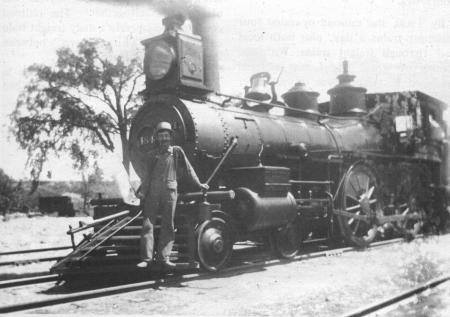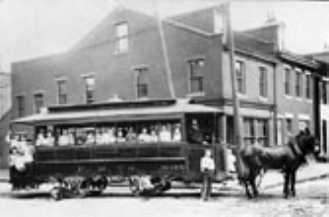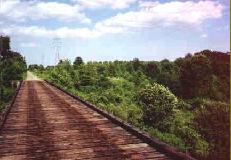|

|
| GRAND TRUNK TRAIN-1890 |

|
| HORSE DRAWN OMNIBUS |
The coming of the steam railroads with their wood burning engines proclaimed the doom of plank roads.
Michigan's early railroad program and canal projects were both spawned by the Michigan Internal Improvements program
of the 1830s. Private corporations were chartered to build railroads to connect all the important cities and villages
in the State.
The first railroad to be authorized in Macomb County was designated as the Romeo and Mount
Clemens Railroad Company and was incorporated in 1833 with capital stock of $150,000. It was limited to six years for building
and its charter lapsed.
The Detroit and Shelby Railroad Company was the third of only 5 railroads built from
the original pre-1837 charters which numbered 21. It was incorporated on March 7,1834 and began operation in September
1839. It was designed to connect the Campus Martius in Detroit with the settlement of Utica or Leech's Mills in Shelby
Township. The rails of the road were made of poles strapped on to logs and the coaches were to be operated by horsepower.
Great visions of success inaugurated the opening of this road. A three-story hotel was built and preparations made for the
expected growth this project and the Clinton & Kalamazoo Canal would bring to Utica.
But the first car that
started on that eventful day of the railroad's opening did not reach Detroit. Within five miles of its destination at the
Campus Martius, where people waited to acclaim its arrival, something went wrong with the roadbed; the strapped rails spread
and the omnibus or compartment car slid into Conner's Creek!
It ceased operation in 1844 and on March 18,1848, the legislature changed the name to the Detroit, Romeo and Port
Huron Railroad. This name change did not revive the railroad. It was later extended to Bay City and became the Detroit Bay
City Railroad.
It was not until 1859 that the Detroit and Canada Grand Trunk Junction railroad was built through
Macomb County. It was for many years a most important line carrying all through business of the road connecting with the Michigan
Central at West Detroit, and all the large business of the Grand Trunk to and from the west.
In 1869 the Michigan
Air Line, Macomb County's second railroad, was built from Ridgeway (Now Lenox)to Romeo, and was later extended through Washington,
Shelby and to Pontiac.
In 1871 the Detroit-Bay City Railroad was opened and the western part of the county
connected by rail with the outside world. It became part of the Michigan Central System in 1928 and presently is operated
by Conrail. This railroad followed almost exactly the right-of-way established by the old strap railroad company thirty years
before.
The Grand Trunk tracks in northeast Shelby Township have been removed and converted into The Macomb Orchard Trail. The Macomb Orchard Trail is 23 miles from Richmond
to Shelby Township where it crosses Dequindre Road south of 24 Mile Road/Parkdale and becomes the "Clinton River Trail". That
will link to the Paint Creek Trail and to Bloomer Park, Stony Creek, and into Pontiac.

|
| MACOMB ORCHARD TRAIL |
Friends of the Macomb Orchard Trail
Michigan Railroad History
Railroad History Links
Railway Stations
|

